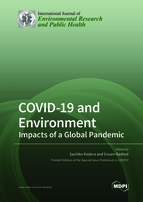COVID-19 and Environment: Impacts of a Global Pandemic
A special issue of International Journal of Environmental Research and Public Health (ISSN 1660-4601). This special issue belongs to the section "Environmental Health".
Deadline for manuscript submissions: closed (31 July 2022) | Viewed by 40256
Special Issue Editors
Interests: human health; risk assessment; computational biophysical modeling
Special Issues, Collections and Topics in MDPI journals
Interests: data analysis and visualization; image processing; pattern recognition and artificial intelligence
Special Issues, Collections and Topics in MDPI journals
Special Issue Information
Dear Colleagues,
We are organizing a Special Issue on “COVID-19 and the Environment: Impacts of a Global Pandemic” on behalf of the International Journal of Environmental Research and Public Health (IJERPH).
The COVID-19 outbreak was first reported in China in 2019 and spread worldwide in early 2020. With the spread of COVID-19 and the corresponding negative impact on different life aspects, it has become important to understand the ways to deal with the pandemic as a part of daily life. Numerous studies on COVID-19 have investigated meteorological factors, clinical features, and public health interventions that affect infection and morbidity. However, problems still exist, and more investigation is required. The major challenges are the limitation of accurate/complete data, the effect of restrictions, and variabilities of medical service quality in different countries. In addition, circumstances are dynamically changing due to policies, vaccines, and the advent of new variants all over the world. The investigation correlation between COVID-19 and environmental factors based on the long-term analysis and data curation would lead to better sustainable management of healthcare resources and government policies.
This Special Issue aims to attract articles of high academic standard investigating the links between the COVID-19 pandemic and environmental factors. We welcome original research papers, systematic reviews, and case reports that address topics related to the COVID-19 pandemic and environmental factors.
We look forward to your contributions.
Dr. Sachiko Kodera
Dr. Essam A. Rashed
Guest Editors
Manuscript Submission Information
Manuscripts should be submitted online at www.mdpi.com by registering and logging in to this website. Once you are registered, click here to go to the submission form. Manuscripts can be submitted until the deadline. All submissions that pass pre-check are peer-reviewed. Accepted papers will be published continuously in the journal (as soon as accepted) and will be listed together on the special issue website. Research articles, review articles as well as short communications are invited. For planned papers, a title and short abstract (about 100 words) can be sent to the Editorial Office for announcement on this website.
Submitted manuscripts should not have been published previously, nor be under consideration for publication elsewhere (except conference proceedings papers). All manuscripts are thoroughly refereed through a single-blind peer-review process. A guide for authors and other relevant information for submission of manuscripts is available on the Instructions for Authors page. International Journal of Environmental Research and Public Health is an international peer-reviewed open access monthly journal published by MDPI.
Please visit the Instructions for Authors page before submitting a manuscript. The Article Processing Charge (APC) for publication in this open access journal is 2500 CHF (Swiss Francs). Submitted papers should be well formatted and use good English. Authors may use MDPI's English editing service prior to publication or during author revisions.
Keywords
- COVID-19
- metrology
- mobility
- epidemiology
- forecasting
- risk assessment
- risk management
- data analysis
- pandemic modeling







